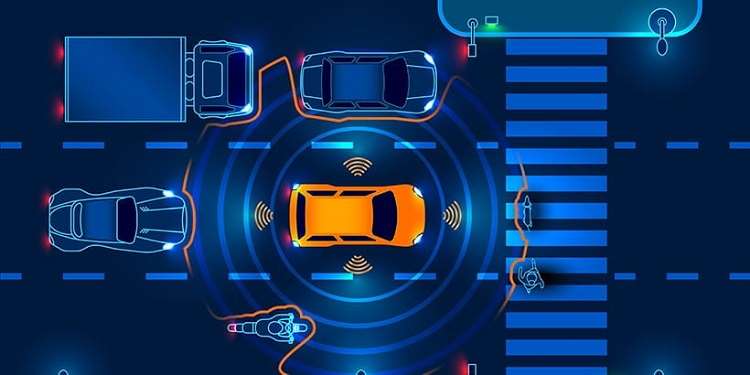garhkal
Sovereign Protector


Joined: 17 Jul 2005
Posts: 14382
Location: Reynoldsburg, Columbus, Ohio.
|
 Posted: Wed Nov 16, 2022 1:56 am Post subject: Posted: Wed Nov 16, 2022 1:56 am Post subject: |
 |
|
| KageRyu wrote: | | I do not think that the creators could have envision what exists today, and did not feel confident bluffing it. |
That is a great point. WHAT folks may now complain about, the Designers, when they made the films/games, back in the 80s, COULD NOT Have even predicted.. Such as hand held phones which also act as portable pcs.. Or lots of most modern vehicles have auto detecting crash sensors, that activate breaks, so why can't land speeders have similar etc...
| KageRyu wrote: | | The most common reason typical radar typed devices were not and are not effective on ground vehicles is house easily uneven ground, trees, obstacles, and even weather can foul it (ever fight a radar enforced traffic ticket with the excuse that due to rain the reading could not be accurate?). |
Yea. Though mine was because there was no proper "Calibration" sticker ON the radar gun...
| KageRyu wrote: | | I would suggest limiting true sensors to specialty vehicles, such as Command and Control units, Electronic Warfare Units, advanced Scout Units. That's not to say that the empire might not have a special variant of the AT-ST for such tasks. |
That i can agree with, scouts or C&C units may have them. BUT generally not every vehicle will..
| CRMcNeill wrote: | | I feel compelled to point out that, even in ANH, Luke's crappy speeder had a scanner capable of detecting a droid in the open desert, so there is obvious precedent for at least basic sensor systems in even low-end civilian vehicles. |
True, but since they RELIED On droids, and had a good few hundred acres of land to cover, it would make SENSE for his Land speeder, to have a droid detector inside..
_________________
Confucious sayeth, don't wash cat while drunk! |
|
CRMcNeill
Director of Engineering


Joined: 05 Apr 2010
Posts: 16428
Location: Redding System, California Sector, on the I-5 Hyperspace Route.
|
 Posted: Wed Nov 16, 2022 9:22 pm Post subject: Posted: Wed Nov 16, 2022 9:22 pm Post subject: |
 |
|
| garhkal wrote: | | CRMcNeill wrote: | | I feel compelled to point out that, even in ANH, Luke's crappy speeder had a scanner capable of detecting a droid in the open desert, so there is obvious precedent for at least basic sensor systems in even low-end civilian vehicles. |
True, but since they RELIED On droids, and had a good few hundred acres of land to cover, it would make SENSE for his Land speeder, to have a droid detector inside.. |
That's beside the point. If they can fit a sensor pack into a PoS landspeeder because it needs it, then they can absolutely fit sensors into larger and more complex military vehicles that need them to locate, target and destroy the enemy. If anything, the military would have a greater need for onboard sensors than would a moisture farmer riding herd on his droids.
_________________
"No set of rules can cover every situation. It's expected that you will make up new rules to suit the needs of your game." - The Star Wars Roleplaying Game, 2R&E, pg. 69, WEG, 1996.
The CRMcNeill Stat/Rule Index
|
|
Inquisitor1138
Captain


Joined: 28 Nov 2021
Posts: 616
Location: Hoth. Or Ilum...
|
 Posted: Tue Jan 02, 2024 9:46 pm Post subject: History of Vehicle Sensors, reality OverLoaD Posted: Tue Jan 02, 2024 9:46 pm Post subject: History of Vehicle Sensors, reality OverLoaD |
 |
|
i am reeling... physically & mentally exhausted...
On A Lark i thought i'd try a google search for this thread. Hoo-boy! That's a rabbit-hole!
This thread not in the first 75 or so, & i wasn't willing to risk a browser crash because scrolling down, their is no page bottom, it just loads more...
| Different Sensors Used in Modern Cars and Their Functions wrote: |
Here's a list of the most common sensors found in vehicles at a glance:
| Code: | Sensor Function
Oxygen Sensors Measure the presence of oxygen in the exhaust system.
Mass Air Flow (MAF) Sensor Measures the volume of air in the engine intake.
Engine Oil Level Sensor Measures the level of engine oil in the engine.
Engine Oil Pressure Sensor Monitor oil pressure in the engine.
Coolant Temperature Sensor Monitors the temperature of the coolant circulating the engine.
Coolant Level Sensor Monitors the level of coolant in the engine cooling system.
Air Intake Temperature Sensor Measures the temperature of the air in the air intake.
Manifold Absolute Pressure (MAP) Sensor Measures pressure difference between the outside and the engine manifold.
Boost Pressure Sensor Monitors the amount of pressure between the turbo and the engine.
Engine Knock Sensor Monitors engine knocking and adjusts ignition timing accordingly. |
|

| Sensor technologies in the modern vehicle wrote: | Different Sensor Technologies Have Different Strengths
Among the many sensors in a modern vehicle are cameras, radar, and numerous types of LiDAR, depending on the function. Early applications in cars for sensors were for basic advanced driver assistance systems (ADAS) with rear-view cameras to help drivers back up more safely. The more autonomous the vehicle, the more sensors required. The sensors that collect information about the vehicle’s surrounding environment as well as inside the cabin fall into the following broad categories:
• Cameras: The sensor that is closest to human vision, a camera collects images to be analyzed by computer algorithms. Among the images an automotive camera collects, one regards information about the environment surrounding the car, including other vehicles, pedestrians, cyclists, road signs, signals, and curb trajectories. Algorithm processing enables the object detection necessary for lane-departure warning and forward-collision warning.
• Radar: A millimeter-wave (mmWave) radar can “see” better than a camera, making it advantageous for certain automotive applications, boasting high resolution and performance, and good directivity, while also being less prone to interference or getting affected by the weather. However, mmWave radar is limited to ADAS functions due to higher costs; it’s also less effective for identifying non-metallic objects.
• LiDAR: A light-based sensor technology, LiDAR sends out pulses of rapid laser signals that bounce back from obstacles, including other vehicles, cyclists, pedestrians, or a mailbox at the end of a driveway. A LiDAR-based instrument measures the time it takes for a pulse to bounce back so that distance between the vehicle and the obstacle can be calculated with accuracy. Mechanical LiDAR directly drives a laser beam by using mechanical parts. While it’s more accurate, offers a 360-degree field of view, and travels longer distances, mechanical LiDAR is expensive to manufacture. Solid-state LiDAR is more affordable, mainly relying on electronic components to control the laser-emission angle, but scanning angles are more limited and it’s less accurate.
• 3D Time of Flight (ToF) LiDAR: Another type of LiDAR that can address a growing number of short-distance automotive use cases is 3DToF LiDAR, which is scanner-less and can achieve a higher level of detail. It’s an increasingly popular type of LiDAR for many different devices, including smartphones, where it can enable a camera sensor to measure distance and volume using high-power optical pulses in durations of nanoseconds to capture depth information, typically over short distances, from a scene of interest. In an automotive environment, 3DToF LiDAR can scan and track objects, support gesture recognition and reactive altimeters, and build a 360-degree view outside the vehicle to assist with parking.
• LiDAR has several advantages as an autonomous vehicle sensor. It has superior range, angular, and speed resolution, while also being much less prone to interference. LiDAR can also acquire a vast amount of information, including distance, angle, speed, and reflection intensity of an object to generate a multi-dimensional image of it. Distance is a determining factor as to whether a short-, medium-, or long-distance LiDAR architecture is best, including for numerous functions inside a car, not just outside to enable autonomous driving.
"Today’s automobile can contain more than 200 sensors depending on its level of autonomy" |
| Get ready for a wave of human-centric sensors | Automotive News Europe wrote: | When did cars get sensors?
Dec 20, 2022
Having sensors in cars is not new. Automakers first introduced rudimentary sensors such as warning lights for low oil pressure in the 1950s. It was simple engineering, but the sensors effectively alerted drivers to potential problems. As technology evolved, so did sensor capabilities and their applications in the auto industry.
By 2020, the average car had nearly 100 sensors (a Formula One racecar boasts more than 300 sensors), and this number is predicted to keep growing. Sensors are fundamental to safe driving --they keep us on the road and help us avoid potentially catastrophic accidents. |
| The evolution of vehicle sensor systems wrote: | Ultrasound: Cheap and robust
Since the early 1990s
Cameras: For an all-round view
Radar: For correct distancing
Lidar systems for real-time image recognition |
Ironic, the real-world paradigm shift in automobiles having sensors to 'look around' the car's vicinity, happened in the nineties, when WEG was still making the SWRPG & supporting products...
So, in short, yes, the vast majority of vehicles in the SWU did have sensors, but most were nothing worth writing home about. How far would civilian vehicles need to 'see' anyway?
Speeder Bikes & Swoops being less likely to have them, making them options instead of standard.
As i recall, Maul's & Dooku's speeders had display screens, which probably included several sensors. Were there sensors on the speeders in RotJ? Possibly, probably a dash-cam or equivalent...
so now to figure out benchmark ranges for civilian speeders, speeders for scouting & exploration, then the military's speeders.
i have some ideas, but i am open to suggestions.
Thank you all, and take care!
_________________
Facing all that you fear will free you from yourself.
  
The Rancor Pit Library
Bounty Hunting is a Complicated Profession... Wouldn't you agree?
Game Mastering is a Complicated Profession... Wouldn't you agree?
Count Dooku: Your swords, please. We don't want to make a mess of things in front of the Chancellor. |
|



